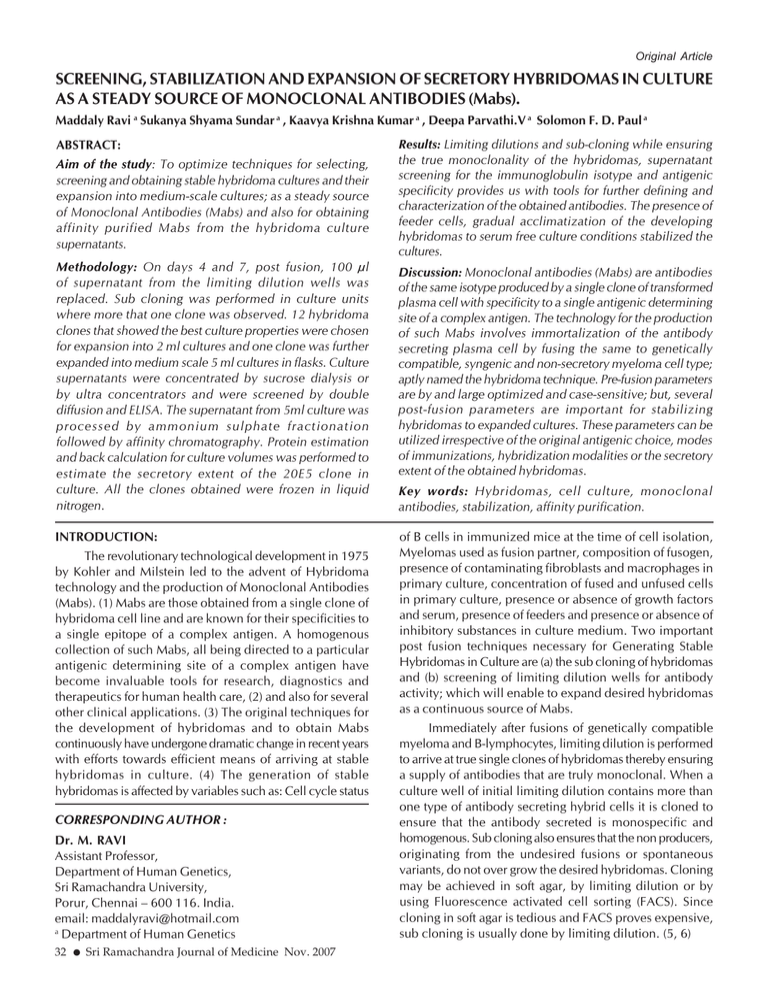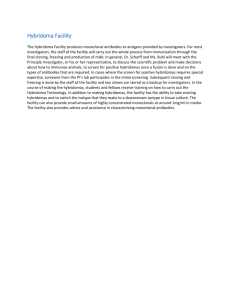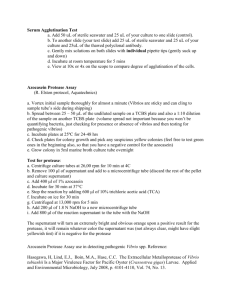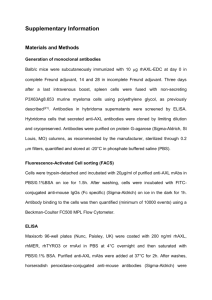SCREENING, STABILIZATION AND EXPANSION OF SECRETORY HYBRIDOMAS IN CULTURE
advertisement

Original Article SCREENING, STABILIZATION AND EXPANSION OF SECRETORY HYBRIDOMAS IN CULTURE AS A STEADY SOURCE OF MONOCLONAL ANTIBODIES (Mabs). Maddaly Ravi a Sukanya Shyama Sundar a , Kaavya Krishna Kumar a , Deepa Parvathi.V a Solomon F. D. Paul a ABSTRACT: Aim of the study: To optimize techniques for selecting, screening and obtaining stable hybridoma cultures and their expansion into medium-scale cultures; as a steady source of Monoclonal Antibodies (Mabs) and also for obtaining affinity purified Mabs from the hybridoma culture supernatants. Results: Limiting dilutions and sub-cloning while ensuring the true monoclonality of the hybridomas, supernatant screening for the immunoglobulin isotype and antigenic specificity provides us with tools for further defining and characterization of the obtained antibodies. The presence of feeder cells, gradual acclimatization of the developing hybridomas to serum free culture conditions stabilized the cultures. Methodology: On days 4 and 7, post fusion, 100 µl of supernatant from the limiting dilution wells was replaced. Sub cloning was performed in culture units where more that one clone was observed. 12 hybridoma clones that showed the best culture properties were chosen for expansion into 2 ml cultures and one clone was further expanded into medium scale 5 ml cultures in flasks. Culture supernatants were concentrated by sucrose dialysis or by ultra concentrators and were screened by double diffusion and ELISA. The supernatant from 5ml culture was processed by ammonium sulphate fractionation followed by affinity chromatography. Protein estimation and back calculation for culture volumes was performed to estimate the secretory extent of the 20E5 clone in culture. All the clones obtained were frozen in liquid nitrogen. Discussion: Monoclonal antibodies (Mabs) are antibodies of the same isotype produced by a single clone of transformed plasma cell with specificity to a single antigenic determining site of a complex antigen. The technology for the production of such Mabs involves immortalization of the antibody secreting plasma cell by fusing the same to genetically compatible, syngenic and non-secretory myeloma cell type; aptly named the hybridoma technique. Pre-fusion parameters are by and large optimized and case-sensitive; but, several post-fusion parameters are important for stabilizing hybridomas to expanded cultures. These parameters can be utilized irrespective of the original antigenic choice, modes of immunizations, hybridization modalities or the secretory extent of the obtained hybridomas. INTRODUCTION: of B cells in immunized mice at the time of cell isolation, Myelomas used as fusion partner, composition of fusogen, presence of contaminating fibroblasts and macrophages in primary culture, concentration of fused and unfused cells in primary culture, presence or absence of growth factors and serum, presence of feeders and presence or absence of inhibitory substances in culture medium. Two important post fusion techniques necessary for Generating Stable Hybridomas in Culture are (a) the sub cloning of hybridomas and (b) screening of limiting dilution wells for antibody activity; which will enable to expand desired hybridomas as a continuous source of Mabs. The revolutionary technological development in 1975 by Kohler and Milstein led to the advent of Hybridoma technology and the production of Monoclonal Antibodies (Mabs). (1) Mabs are those obtained from a single clone of hybridoma cell line and are known for their specificities to a single epitope of a complex antigen. A homogenous collection of such Mabs, all being directed to a particular antigenic determining site of a complex antigen have become invaluable tools for research, diagnostics and therapeutics for human health care, (2) and also for several other clinical applications. (3) The original techniques for the development of hybridomas and to obtain Mabs continuously have undergone dramatic change in recent years with efforts towards efficient means of arriving at stable hybridomas in culture. (4) The generation of stable hybridomas is affected by variables such as: Cell cycle status CORRESPONDING AUTHOR : Dr. M. RAVI Assistant Professor, Department of Human Genetics, Sri Ramachandra University, Porur, Chennai – 600 116. India. email: maddalyravi@hotmail.com a Department of Human Genetics 32 NSri Ramachandra Journal of Medicine Nov. 2007 Key words: Hybridomas, cell culture, monoclonal antibodies, stabilization, affinity purification. Immediately after fusions of genetically compatible myeloma and B-lymphocytes, limiting dilution is performed to arrive at true single clones of hybridomas thereby ensuring a supply of antibodies that are truly monoclonal. When a culture well of initial limiting dilution contains more than one type of antibody secreting hybrid cells it is cloned to ensure that the antibody secreted is monospecific and homogenous. Sub cloning also ensures that the non producers, originating from the undesired fusions or spontaneous variants, do not over grow the desired hybridomas. Cloning may be achieved in soft agar, by limiting dilution or by using Fluorescence activated cell sorting (FACS). Since cloning in soft agar is tedious and FACS proves expensive, sub cloning is usually done by limiting dilution. (5, 6) Original Article The purpose of screening is to identify wells containing hybridomas that secrete antibody of desired specificity. The early identification of monoclonal antibodies with the desired specificities is the most critical step in monoclonal antibody production. The initial screening for antibody activity should be done as soon as growth of hybrid cells is seen under the microscope or upon a change in culture medium pH. Although cells have been diluted to limit the number of independent hybrid cells per well, it is important to realize that, a positive clone (secreting the desired antibody) may be detected soon after fusion, but then might be lost due to overgrowth of a negative or other positive clone and also no activity may be detected during the first assay due to the cells of a positive clone being a minority. It is therefore essential to test negative supernatants from actively growing cultures on two or three occasions. The type of assay used to detect the antibody depends on the nature of the antigen and the type of antibody desired. During the initial screening, for the selection of positive hybrids for cloning, speed, convenience and reproducibility are essential. Technically simple, sensitive and convenient assays are used to screen large number of supernatants to identify the wells containing desired antibodies. Generally screening assays use labeled reagents to detect antibodies. These assays are performed in solid phase and assay the antibodies using reagents labeled with either radioisotopes (radioimmunoassay-RIA) or enzymes (enzyme linked immunosorbent assay- ELISA). Once a clone has shown to secrete antigen specific Mab, efforts should be taken to preserve this clone, allowing them to grow to confluency and supernatants should be screened periodically for antibody activity (7, 8) Freshly isolated hybrid cell cultures grow slowly and the volume of cell culture is expanded slowly either in vivo (in animals) or in vitro (in culture flasks). Once the monoclonality of the cultures has been established, the clones are grown sequentially in increasing volumes of culture medium to develop a suitable stock of antibody producing cells. The colonies or cloning wells are transferred to flasks containing medium and diluted with medium as and when there is a change in pH. The Mabs are secreted and it accumulates in the spent medium of the cultured flasks. in vivo expansion is done by injecting these tumorigenic lines intraperitonially into histocompatible mice and large amounts of hybridoma derived antibody are then secreted into the ascetic fluid from which they can be purified (8) Accustoming the hybridoma cells to serum free (SF) medium can be done in different ways and requires adapting cells to SF medium and to establishing the adapted cells in SF medium (needs at least 4-6 weeks of continuous passaging until Mab producing sub lines have established themselves in stable growth). Accustoming can be done in different ways such as by replacing the serum containing medium entirely with SF medium without any adaptation phase; by reducing the serum content slowly over a number of passagesmore gentle method but requires a comparatively longer time or also by plating out the same number of cells in medium with decreasing concentration of serum and to which serum replacement has already been done. However the growth and behavior of cells in SF media cannot be predicted and the doubling time of hybridomas may remain the same or may be prolonged under such conditions. Antibody production can be just as good under SF conditions or higher productivity remaining stable for longer periods can be observed. (5, 9) Apart from the presence of contaminating viruses and mouse Ig along with the secreted Mab in ascites fluid, in vivo expansion of hybridomas proves lethal to the animal and is at present not practiced owing to ethical reasons. in vitro expansion of hybridomas result in secretion of Mab into culture supernatants that are collected and assayed periodically. Immunoglobulins can be isolated and purified by ammonium sulphate precipitation, ultracentrifugation, ultra filtration, and column chromatography (gel filtration, ion exchange or affinity) (5, 10) Here, we describe the screening, stabilization and expansion of secretory hybridomas in culture as a steady source of monoclonal antibodies (Mabs). Double Diffusions and ELISA were used for screening the supernatants both for the immunoglobulin isotype identification as well as for the specificities of the antibodies. One hybridoma clone, 20E5 was chosen for sequential transfer, acclimatization and expansion to higher culture volumes in serum free conditions. The supernatant was collected and affinity purification of Mab 20E5 was performed along with deriving at the rate of immunoglobulin secretory activity of the said clone in culture. MATERIALS AND METHODS: The details of protocols used for obtaining hybridomas such as the antigenic choice, methods of immunization and parameters for limiting dilutions are discussed elsewhere. (11) Briefly, murine splenocytes were immunized in vitro with protein extracts of Chinese Hamster Ovary (CHO) mitotic cells. Sp2/0 cells (histocompatible, non-secretory syngenic myeloma cells) were used as fusion partners and limiting dilutions performed in the presence of syngenic feeder cells in selective medium containing Hypoxanthine, Aminopterin and Thymidine (HAT medium). Maintaining Hybridomas in Culture On days 4 and 7, post fusion, 100 µl of supernatant from the limiting dilution wells was aspirated by suction and the wells were refed with 200 µl of fresh HAT medium, supplemented with conditioned medium with/ without serum and incubated at 37 ºC; 5% CO 2. The wells containing more than one hybridoma clone were identified and sub cloned. The hybridomas from such wells were Sri Ramachandra Journal of Medicine Nov. 2007 N33 Original Article Figure 1: Syngenic Feeder Cells after 1 week of plating as a stabilizing zone for the single hybridoma cells immediately after limiting dilution and also as a source of conditioning medium for further early expansions of the positive secretory clones. (Inverted Phase Contrast; Magnification: 40 X) aspirated after gentle mixing, and limiting dilution was done on 96 well plates containing feeder cells (Figure 1) in HAT medium. For the expansions, 13 actively growing hybridomas were aspirated from 96 well plates, and added into 2ml HAT in 24 well plates. One ml of supernatant from the wells containing actively expanding hybridomas were collected into clean eppendorf tubes periodically and screened. The wells were re fed with one ml hybridoma SF medium (with 10% FBS) and the plates incubated at 37 ºC; 5 % CO2. The supernatants collected were concentrated by sucrose dialysis (for larger supernatant volumes) or using ultra concentrators with cut-off of 50K and screened for antibody by Ouchterlony double diffusion (ODD) and ELISA. Figure2:Atypical young hybridoma clone stabilizing in culture in the presence of feeder cell.The spherical cells are the hybridomas whereas the cells with extended morphology are the feeder cells. (Inverted Phase Contrast; Magnification 40 X) One clone 20E5 (Figure 2) was chosen for further expansions into T-25 flasks and the supernatant was concentrated followed by fractionation of antibodies and finally to obtain affinity purified Mabs. 8 ml of supernatant from actively expanding Hybridoma was collected into dialysis tubing and was placed on sucrose powder in a pertidish. The tubing was covered completely with sucrose powder and left undisturbed at room temperature. The moist 34 NSri Ramachandra Journal of Medicine Nov. 2007 sucrose powder was periodically replaced, and carefully monitored until the supernatant loaded showed a marked decrease in volume. The concentrated supernatant was then collected in a clean eppendorf tube, labeled and stored at 4 ºC. Supernatant samples from clones in 2ml cultures, of about 0.5 ml volumes, ultra concentrators with a molecular weight cut-off of 50 KDa were used for concentrations. The supernatants were loaded into the ultra concentrators and centrifuged at 10,000 rpm for 5 minutes at 4 ºC. Following centrifugation, the filtrate was discarded and the sample was reloaded and centrifuged. The retentate containing the concentrated proteins were collected in a clean eppendorf tubes, labeled and stored at 4 ºC. The concentrated samples were screened for specific activity to anti- mouse IgG whole serum and anti- mouse whole serum by ODD. 1 % Agarose was prepared in PBS as slides. Wells were punched in the gel and scooped. 10 µl of supernatant was added to the central wells and 10 µl of anti- mouse IgG whole serum and anti- mouse whole serum were loaded in the peripheral wells. The slides were left in a humid chamber at room temperature overnight. The following day, the Agarose slides were observed for the presence or absence of precipitin bands. The slides were documented by several washes in PBS to remove unbound proteins, stained with Coomassie Brilliant Blue, and heatdried. Ouchterlony Double Diffusion was performed in 5ml, 1% Agarose Gels in Saline on standard microscope glass slides for several supernatants from about 10th day of limiting dilution. Typically, about 5 supernatants were screened at a time in one gel slide as a continuous process right up to the final concentrated supernatants of the 13 clones. As the process was routine and standard technique, gel preservation followed by documentation was not made. However, the ELISA screening of the same supernatants are well documented as we used a software based approach and the details of the Plate lay-out, Programme used, Absorbance Readings directly on the wells are well documented and data stored. The same samples were then screened for specific activity to the CHO mitotic cytosolic protein antigen by ELISA. The antigenic coating to the wells of the ELISA plates is done by dissolving the antigen in a coating buffer. A 50% antigen was prepared as 1:1 v/v ratio of CHO mitotic cytosolic protein in the coating buffer and 100 µl was added to each of the wells of the ELISA plate. The plates were incubated at 4ºC overnight. Following incubation, the plates were washed once with 200µl washing solution and the unreacted sites blocked with blocking solution. The plate was incubated at 37ºC for an hour following which, the plate was decanted and washed thrice with 200 µl of wash solution. 50µl of each of the concentrated supernatant was added to the respective wells and incubated at 37 ºC for an hour. The plate was decanted and washed thrice with 200 µl of wash solution. 100 µl of 1x anti-mouse IgG Original Article HRP conjugate was added to each well and incubated at 37 ºC for an hour. Following incubation, the wells were decanted, washed thrice with 200µl of wash solution and 100 µl of substrate solution (TMB/H2O2 in substrate buffer) was added, incubated at room temperature for 10 minutes. The reaction was arrested following development of blue color which turned yellow upon addition of stop solution and OD read at 450 nm. Fractionation of Mabs by Ammonium Sulphate Precipitation The supernatant from 20E5 expanded culture was centrifuged at 10000rpm for 10 minutes at 4 ºC. To the supernatant 45% v/v of saturated ammonium sulphate was added and incubated at 4 º C overnight. The following day the tubes were centrifuged at 10,000 rpm for 30 minutes. After centrifugation, the supernatant was discarded and the pellet was dissolved in 1ml PBS, loaded in dialysis membrane and left in 250 ml PBS overnight at 4 º C. PBS was changed periodically and extent of dialysis was monitored by the extent of precipitate formed with barium chloride in the spent PBS. Affinity Purification of Mabs by Chromatography The Protein-A CL- Agarose Column was equilibrated with 15ml of equilibration buffer. Following equilibration of the column, 1.5 ml of the fractionated antibody sample was mixed with equal volume of equilibration buffer and loaded into the column. The undesired proteins present in the sample were washed using the equilibration buffer. The desired fraction containing monoclonal antibodies of the IgG isotype were eluted using 15ml of the elution buffer. The eluted sample was collected in a 15ml centrifuge tube, and neutralizing buffer 25 µl/ml of sample was added, and the tube was labeled and stored at -20 ºC. The column was washed with storage buffer and stored at 4 ºC. Protein estimation of the affinity purified Mabs was done by Bradford method. Freezing of Hybridomas The cells from actively, expanding hybridomas were collected in 0.5 ml of Freezing medium; transferred to sterile cryovials, with the well numbers labeled on the cryovials and stored in cryopack at -70º C for 3 hours to ensure the reduction of temperature of -1 ºC every one minute. After three hours the vials were transferred to canisters and stored in liquid nitrogen in cryocans. Figure 3: Micro culture plates of 96 wells, ten days after limiting dilution showing distinct change in medium color indicating wells with metabolic activity associated with cell division and growth. Pink colored wells indicate the original color of the medium where there is no apparent cellular activity and various shades of yellow indicate sufficient activity necessitating the need for screening such supernatants for Mab. A small number of wells showing multiple clones of cells were observed. (Figure 4) These were sub cloned by limiting dilution to ensure monoclonality of the hybridomas. To obtain, sufficient quantities of supernatants for screening, the hybridomas were expanded into serum free DMEM, supplemented with HAT in 24 well plates. The plates were incubated at 37 ºC; 5 % CO2 and regularly observed for the development of clones. RESULTS: Re-feeding of limiting dilution wells was done on day 4 and 7 post fusion as guided by the rate of cell growth. This was done by removing of about half the culture medium by suction, followed by its replacement with fresh HAT medium. (With 10 % conditioned medium). Nonetheless, few of the wells showing rapid change in color of medium and increased cell density were refed more often. (Figure 3) Figure 4: A culture unit showing two simultaneously developing healthy hybridoma clones necessitating the need for sub-cloning to ensure the true monoclonality of the hybridoma cell line and subsequent monospecificity of Mabs secreted. (Inverted Phase Contrast; Magnification 40 X) Sri Ramachandra Journal of Medicine Nov. 2007 N35 Original Article Supernatants from T-25 flasks with expanded hybridoma cultures were concentrated 5 folds using sucrose. 8ml of supernatant loaded initially yielded 1.5 ml of concentrated sample. Concentration of supernatants resulted in its decreased volume and an apparent change in its color (appeared darker) was observed. The supernatants of lower volumes (from 1ml cultures) were concentrated 10 folds by using ultra concentrators yielded a final volume of 100 µl from an initial volume of one ml. The concentrated samples were collected in eppendorf tubes, labeled and stored at 4 ºC. ODD results showed the presence of precipitin line between wells containing the supernatant and those containing anti mouse IgG whole serum and anti mouse whole serum. The precipitin bands obtained between wells S.No 1. 2. 1 containing supernatant and anti mouse IgG whole serum were sharper, than the one in between the wells containing the supernatant and anti mouse whole serum indicating the presence of Mabs of the IgG isotype. The ELISA results obtained showed the presence of monoclonal antibodies of the IgG isotype in all 13 the supernatants tested. However, the concentration of IgG present in the supernatant varied within close range. In Figure 5, the numbers denote supernatants obtained from the specific wells of 96 well plates that contain hybridomas derived from splenocytes exposed to particular antigenic volume. For eg 10 D5denotes the supernatant from the wells that contain hybridomas obtained from D5 well of 96 well plates that have been exposed to 10µl of antigen. 2 3 4 5 6 7 8 9 Supernatant from well 10 D5 10 F9 20 E5 10 C8 15 E5 10 G6 10 F3 20 C7 20 C8 20 D9 10 G10 15 D4 10 F5 OD value 0.117 0.111 0.122 0.121 0.106 0.11 0.119 0.117 0.116 0.115 0.103 10 11 0.121 12 0.114 13 Figure 5: ELISA OD values obtained by screening the hybridoma supernatants for specific antigen. One clone 20E5, apart from being an antigen specific hybridoma, showed the best cultural characteristics, rapid doubling time, and thus selected for expansion into T-25 flasks and supernatant collected after sufficient metabolic activity was observed. (Figure 6) The Mabs were isolated from culture supernatants by ammonium sulphate precipitation, purified by dialysis and IgG isotype isolated by affinity chromatography. Salt fractionation yielded 8ml of suspension from 15ml of supernatant. Finally, 1 ml of Affinity Purified Mab (in Phosphate Buffered Saline) with a protein concentration of 92.5 mg / ml was obtained by Protein-A affinity chromatography. Therefore, the hybridoma clone 20E5 was secreting 06.16 mg / ml of Mab into the supernatant in culture. (Figure 7) Figure 6: A healthy expanding hybridoma clone with secretory properties about ten days further to limiting dilution in the presence of feeder cells. (Inverted Phase Contrast; Magnification 20 X) Figure 7: A semi confluent culture of the Hybridoma clone in the presence of feeder cells, 15-20 days further to limiting dilution. (Inverted Phase Contrast; Magnification 20 X) 36 NSri Ramachandra Journal of Medicine Nov. 2007 Original Article The healthy hybridomas were frozen in 1.0 ml of cell freeze medium in cryovials and were stored in liquid nitrogen. DISCUSSION: Polyclonal antisera owing to greater avidity to a polyvalent antigen has wide applications in areas where such multiple interactions are required as in the case of heamagglutination, or whole-bacterial agglutination and complement mediated lysis. The advantages of such polyclonal antibody generation are distinct in typical “in vivo” situations. Monoclonal antibodies (Mabs) on the other hand have become indispensable for finer “in vitro” applications as well as in increasing usage in human diagnostics and therapeutics. The technical modalities of the generation of hybridomas have seen much refinement since their original description. Major challenges here are to ensure a stable, healthy hybridoma culture as a source of monoclonal antibodies, the time and cost involved in such production and also the isotype of the Mabs produced. Some of these were addressed by the recent developments such as “in vitro” immunizations of murine splenocytes which eliminated repeated animal handling, circumvented the need for booster doses of antigenic administration and test sera check for a generated immune response in the experimental animals. Also, a distinct advantage is the considerable reduction in time required for stimulation of eretentate and can thus be concentrated. Concentration resulted in increased antibody concentrations in lower supernatant volumes thereby increasing the sensitivity. Initial screening of hybridoma supernatants to check for the presence of antibodies was done using Ouchterlony double diffusion. Subsequent screening was done using techniques with relatively higher sensitivity, (that did not require concentration of supernatants) such as ELISA. ELISA with Antimouse IgG confirmed the IgG isotype of the secreted Mabs and ELISA with the antigen gave us the specific nature of the antibodies. While ODD required concentrated supernatants for identification of secreted Mabs, ELISA being a more sensitive technique did not require the same. The IgG isotype antibodies are preferable to the initial IgM response as for a variety of applications not only owing to the high affinity but also because secondary Antimouse IgG conjugates (either with dyes or enzymes) are readily available. (13) Such IgG responses were achieved by a slightly extended duration of immunization in this study without compromise on the health of the splenocytes. Mabs were fractionated using ammonium sulphate precipitation method and were further affinity purified using a Protein A column. The hybridomas are fragile initially after fusion and are different from the parental cell types. Several factors such as random chromosome loss can either turn secretory cells non-secretory or the hybridomas might even collapse and fail to expand. A very important step in Hybridoma technology is to obtain the hybrid cells essentially as a continuous culture. The present study highlights on the parameters that can be applied for obtaining continuous stable cultures. While previously reported studies give us a detailed account on the production of Human Mabs, (14, 15) the combination of those techniques for immunization and immortalization of the clones in conjunction with those described above for the stabilization and expansion of secretory hybridomas can result in enhancing the applicatory potential of the Mabs for research, diagnostics and therapeutic. CONCLUSION: The screening techniques utilized and described in this study gave us the differentiation of positive secretory clones and nonsecretory clones. Also, the isotype of the antibodies and their specificities were ascertained by the screening techniques. Stabilization of the desired hybridoma clones as cell-lines in culture was optimized by expansions from 96 well plates as 0.2ml cultures to 5 ml cultures in T-25 flasks. While sucrose dialysis was employed to concentrate larger volumes of the culture supernatants, smaller volumes were concentrated by ultra-concentrators with 50 KDa cutoffs that gave us culture supernatants with detectable quantities of Mabs even by double diffusions while ELISA was employed for more sensitive screening. Healthy expanding hybridomas were identified and cryopreserved. The culture supernatant from the clone 20E5 was harvested, fractionated and affinity purified which yielded antigen specific Mabs of the IgG isotype. The techniques employed and described above are not antigen-specific and can readily be employed for obtaining a constant source of Mabs specific for any antigen which are invaluable biological reagents for a variety of purposes towards human health care. REFERENCES 1. Kohler G, Milstein C. Continuous culture of fused cells secreting antibody of predefined specificity. Nature 1975;256:495-497. 2. Edwards PAW. Some properties and applications of monoclonal antibodies. Biochem. J. 1981;200:1-10. 3. Payne WJ, Marshall DL, Shockley RK, Martins WJ. Clinical laboratory applications of monoclonal antibodies. Clin. Microbiol. Rev. 1988;1:313-329. 4. McGregor MC. Monoclonal antibodies: production and use. Bmj 1981;283:1143-44. 5. Peters JH, Baumgarten H. Monoclonal antibodies. Germany: Springer laboratory; 1992. 47- 380. 6. Hudson L, Hay FC. Practical immunology. 3rd ed. Oxford: Blackwell Scientific Publishers; 1989. 367-401. 7. Howard GC, Bethell DR. Basic methods in antibody production and characterization. CRC Press; 2000. 51-53. Sri Ramachandra Journal of Medicine Nov. 2007 N37 Original Article 8. Talwar GP. A Handbook of practical and clinical immunology. 2 nd ed. India: CBS publishers and distributors; 2005. 94-115. 9. Murakami H, Masui H, Sato G, Sueoka N, Chows T, Sueoka TK. Growth of hybridoma cells in serum-free medium: Ethanolamine is an essential component. Proc. Nati Acad. Sci. 1982;79:1158-1162. 10. Wilson K, Walker J, editors. Practical biochemistry: principles and techniques. 5th ed. Cambridge: Cambridge University Press; 2000. 206-234,260. 11. Maddaly Ravi, Sukanya Shyama Sundar, Kaavya Krishna Kumar, Deepa Parvathi.V and Solomon F. D. Paul. Hybridoma Generation by in vitro Immunizations of Murine Splenocytes with Cytosolic Proteins of Chinese Hamster Ovary (CHO) Mitotic Cells. Hybridoma. 2007; In press 38 NSri Ramachandra Journal of Medicine Nov. 2007 12. Boer MD, Ossendorp F, Duijin GV, Voorde T, Tager JM. Optimal conditions for the generation of monoclonal antibodies using primary immunization ofmouse splenocytes in vitro under serum free conditions. J. Immunol. Methods 1989;121:253-260. 13. Takahashi M, Fuller A, and Hurell GR. Production of IgG- Producing hybridomas by in vitro stimulation of murine spleen cells. J. Immunol. Methods 1987;96:247253. 14. Borrebaeck CAK. Human mAbs produced by primary in- vitro immunization. Immunol today 1988;9: 355-59. 15. Borrebaeck CAK. Strategy for the production of human monoclonal antibodies using in vitro activated B cells. J Immunol. Met. 1989; 123:157-65.




